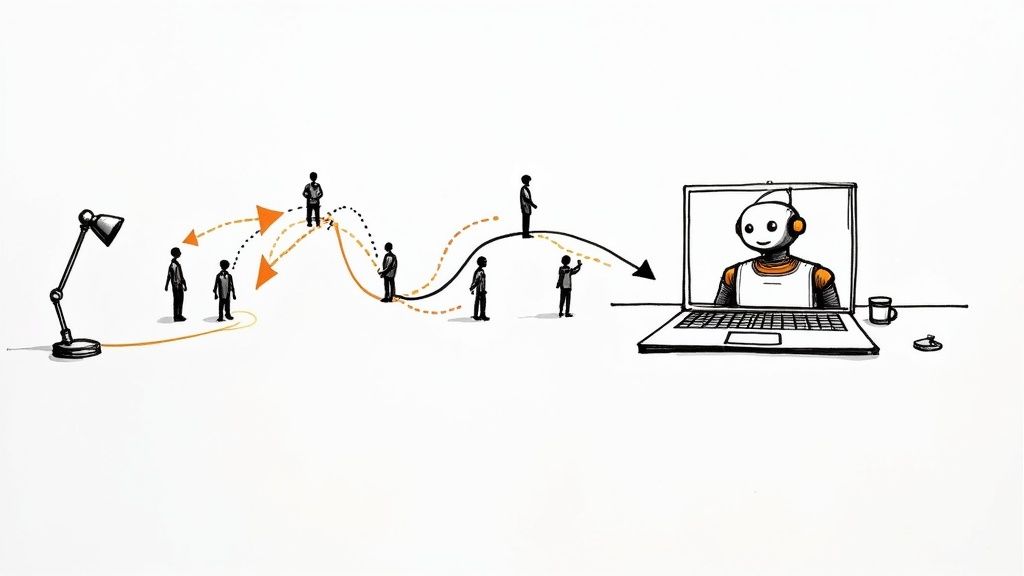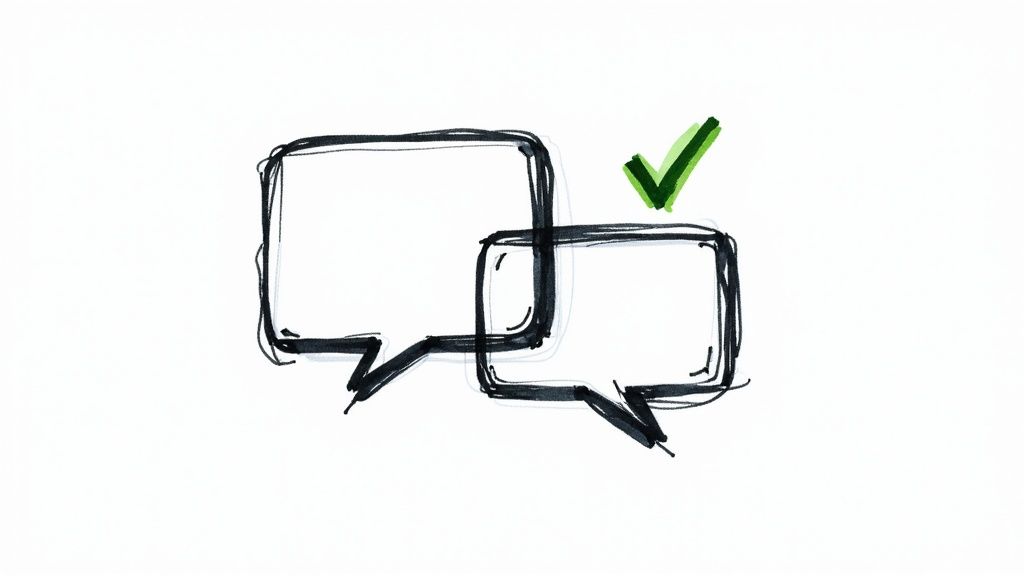
Chatbot for Lead Generation: Converting Visitors Into Sales
When Your Website Visitors Become Conversations
Imagine you're a marketing director, staring at your website analytics. Thousands of visitors each month, yet only a handful convert into leads. Frustrating, right? This struggle is common. The traditional approach of static contact forms and delayed follow-ups is simply not keeping pace with today's customer expectations.
What if your website could engage visitors in real-time conversations, understanding their needs and even scheduling meetings while you're away? This isn't a futuristic dream, it's the power of chatbots for lead generation.
These aren't the intrusive pop-ups you might remember. Think of them more as sophisticated conversational partners. They understand context, recall visitor preferences, and guide prospects through personalized experiences that feel remarkably human.
From Static Pages to Dynamic Conversations
This represents a fundamental shift in how we connect with potential customers online. Think about the typical website visit: a user arrives, browses a few pages, maybe fills out a form, and then…vanishes. Traditional methods often miss the opportunity to capitalize on that initial spark of interest.
Chatbots, however, offer a real-time solution. They provide instant engagement, answering questions, providing support, and smoothly guiding visitors toward the next step. This immediacy is crucial in our fast-paced world.
The Rise of Intelligent Chatbots
Over the last decade, chatbots have rapidly evolved from simple scripted programs to sophisticated AI-driven tools. They can qualify, nurture, and convert leads at scale. In fact, by 2025, over 987 million people are projected to interact with AI chatbots regularly, highlighting their growing global presence. Discover more insights on chatbot growth This shows a clear shift in how people prefer to engage with businesses – they expect instant, personalized communication.
This evolution goes beyond just adding more complex scripts. Modern AI-powered chatbots actually learn and adapt, constantly improving their effectiveness. They use natural language processing (NLP) to understand the subtleties of human conversation, allowing them to provide truly helpful and relevant responses. This personalized touch creates a more engaging experience, leading to more leads and higher conversion rates.
Chatisto: Your Virtual Lead Generation Assistant
Chatisto perfectly embodies this new generation of chatbots. Integrating seamlessly with your website, Chatisto acts as a tireless virtual assistant. It engages visitors in personalized conversations, qualifies leads, and can even book meetings.
Imagine your website transforming from a static source of information into a dynamic lead generation engine, working 24/7 to capture and nurture potential customers. This proactive approach ensures every visitor receives individual attention, maximizing your conversion potential.
Why Traditional Lead Capture Is Failing You
Let's be honest, static contact forms and delayed follow-ups feel a bit like rotary phones in the age of smartphones. Picture this: a potential customer is on your pricing page, showing clear interest, maybe even filling out a form…then vanishes. Two days later, your sales team gets in touch, but the prospect has already signed with a competitor who offered immediate help. This lost opportunity scenario plays out daily, costing businesses valuable leads.
The problem isn't your product; it's the outdated assumption that buyers will patiently wait. Today's customers expect instant, personalized responses. They want to feel understood, not like a cog in your sales machine. They're looking for connection, not a cold, impersonal form.
This shift in buyer behavior makes response time crucial for converting leads. Businesses are losing up to 80% of potential customers simply because their lead capture process feels slow and impersonal.

This infographic shows the impact of real-time engagement on lead generation. It highlights the percentage of leads generated after hours, improved response times, and the resulting boost in conversion rates. As you can see, faster response times – using tools like a chatbot for lead generation – directly correlate with increased conversions and capturing those valuable after-hours leads. For businesses wanting to maximize their potential, real-time engagement isn’t optional anymore—it’s essential.
Understanding the Performance Gap
To better illustrate the advantages of chatbots, let's look at a comparison of traditional lead generation methods versus a chatbot-powered approach.
Let's delve into a comparison table that showcases how traditional lead generation methods stack up against the efficiency of chatbots.
| Metric | Traditional Methods | Chatbot-Powered | Improvement |
|---|---|---|---|
| Response Time | Minutes to Days | Immediate | Significant decrease, often >90% |
| Qualification Accuracy | Moderate, prone to human error | High, based on pre-defined criteria | Noticeable increase, depending on chatbot logic |
| Conversion Rate | Relatively low, impacted by delayed response | Higher, due to real-time engagement | Potential for substantial uplift, often >2x |
As this comparison reveals, chatbot-powered lead generation significantly outperforms traditional methods across key metrics. The immediate response times, improved qualification accuracy, and increased conversion rates highlight the potential of chatbots to transform your lead capture process.
For more ideas on optimizing your lead capture strategy, check out our guide on boosting sales with AI chatbots for lead generation. Today's buyers want instant gratification. They want answers now, not later. Using a chatbot for lead generation, you can give customers the immediate, personalized experience they expect, turning your website into a 24/7 lead-generating powerhouse. This shift not only captures more leads but also builds stronger customer relationships right from the first interaction.
The Psychology Behind Conversations That Convert

Think about your best sales interactions. Did they start by grilling the potential customer about their budget? Probably not. More likely, you started by trying to understand their needs and what they were hoping to achieve. This builds a connection and gently reveals their intent to buy. The most effective chatbots for lead generation work the same way. They use well-timed questions and helpful replies, avoiding a pushy sales pitch.
The Power of the First Impression
That first message is everything. It has to grab attention without making people want to hit the “close” button immediately. Think of it as a warm handshake, not a vice-like grip. Something as simple as "Hi there! How can I help you today?" can be surprisingly effective. This creates a positive initial interaction and encourages engagement.
Asking the Right Questions at the Right Time
Asking the right questions at the right time is like having a roadmap to a successful conversation. Just as a good salesperson guides a conversation, a well-designed chatbot uses questions to understand the prospect's needs. Starting with broader inquiries about their challenges, then getting more specific, helps qualify leads effectively.
For example, instead of jumping straight to budget questions, a chatbot might first ask about current marketing strategies. This helps understand their needs and tailor the next questions accordingly. This feels more like a personalized discussion and less like an automated questionnaire.
Building Trust Through Dialogue
Trust is the foundation of any sale. Chatbots build this by offering something useful at every step. This might mean answering questions, providing resources, or connecting the prospect with a human when it’s needed. This personalized approach makes a positive impression and builds confidence in your brand.
The results speak for themselves. In 2025, businesses saw conversion rates as high as 70% in sectors like eCommerce and SaaS when using chatbots for lead generation, proving how valuable timely, personalized interactions can be. Discover more about chatbot conversion statistics.
From Automated Interrogation to Personalized Consultation
Smart businesses are moving away from rigid, scripted chatbot conversations. They're building flows that feel more like personal consultations. These chatbots analyze responses, adjust to individual needs, and provide tailored information.
This approach creates a more engaging and valuable experience, making conversions more likely. It changes the interaction from a simple transaction into an opportunity to build a relationship. This not only generates leads but also nurtures them, fostering long-term engagement with your brand.
Real Success Stories From The Trenches
Let's talk about David. He's a SaaS startup founder who was struggling – big time. He had tons of website traffic, but hardly anyone was requesting a demo. His contact form was working, sure, but it was mostly attracting people who weren't a good fit for his product. It felt like a massive waste of time and energy.
Then, he started using a chatbot for lead generation. Within six months, his qualified demo requests jumped up by 300%. His sales team was finally talking to the right people – the ones actually interested in buying. The change was incredible; his sales pipeline went from a slow drip to a rushing river.
And David's story isn't unique. Take Maria, for example. She runs an eCommerce business selling specialized equipment. Her old lead generation methods were costing her a fortune – about $200 per qualified lead. That just wasn't sustainable.
Maria decided to try a chatbot designed specifically for her industry. This chatbot could understand complex technical needs and match potential customers with the right products. The result? Her cost per lead dropped to $70, and the quality of her leads actually improved.
These aren't just lucky breaks. They show how businesses are changing the way they connect with potential customers. David and Maria's successes highlight how powerful a well-designed chatbot can be.

This screenshot from the Chatisto case studies page shows more real-world examples of how businesses have used chatbots. It gives you a peek into the strategies they used, the problems they solved, and the real, measurable results they achieved. You can see how customizing the chatbot experience for different industries and audiences can make a huge difference.
Want to learn more? Check out this article on implementing a lead generation chatbot. By looking at these success stories, we can figure out the best strategies and practices. We can see what challenges these businesses faced, and how they used chatbots to overcome them. This gives us a practical understanding of what's really possible. David, Maria, and many others have shown that the right chatbot can completely change the game for lead generation.
Crafting Conversations That Feel Genuinely Helpful

The success of your lead generation chatbot hinges on one key element: the conversation. A chatbot that converts feels like a helpful assistant, not a relentless salesperson. The trick is to gather valuable sales information while simultaneously offering something genuine to the prospect.
This balance isn't always easy to strike. It takes careful planning and a deep understanding of your target audience. But when done well, it can transform your lead generation efforts.
Starting With Curiosity, Not Qualification
Imagine walking into a networking event and immediately bombarding everyone with requests for their business card and budget. A bit off-putting, right? The same applies to chatbots. High-converting chatbots prioritize understanding the visitor's needs and goals before diving into qualifying questions.
This initial engagement builds rapport and trust. It demonstrates that you value the visitor's time and genuinely want to help. For example, a chatbot for Asana might open with, "What are your biggest project management challenges right now?" This sets a collaborative tone and encourages the visitor to share their pain points.
The Power of Contextual Follow-Ups
Active listening is essential for any meaningful conversation, even those with chatbots. Contextual follow-ups are key to demonstrating this. If a visitor mentions struggling with team communication, the chatbot could respond with, "Team communication can be tricky! Are you using any specific tools for that currently?"
This shows the visitor that the chatbot is paying attention and tailoring the conversation to their specific needs. Providing relevant resources, like a link to a blog post about improving team communication or a case study featuring a company that overcame similar challenges, further reinforces the chatbot's helpfulness.
Messaging Frameworks That Build Rapport
Successful businesses leverage messaging frameworks that prioritize helping their prospects. These frameworks often include:
- Problem-focused opening: Start by acknowledging common pain points to resonate with visitors.
- Solution-oriented approach: Position your chatbot as a helpful resource, not just a sales tool.
- Personalized recommendations: Offer tailored advice and resources based on the user's input.
- Seamless handoff to humans: Recognize when a prospect requires more complex assistance and smoothly connect them with a live agent.
Before we move on, let's look at some practical applications of these concepts. The following table provides a breakdown of essential conversation elements, their purposes, and best practices for implementation.
Essential Components of High-Converting Chatbot ConversationsA breakdown of key conversation elements, their purposes, and best practices for implementation
| Conversation Element | Purpose | Best Practice | Common Mistake |
|---|---|---|---|
| Welcome Message | Set the tone and introduce the chatbot's purpose. | Keep it short, friendly, and offer immediate value. | Overly long greetings or generic sales pitches. |
| Initial Question | Understand the visitor's needs and context. | Ask open-ended, problem-focused questions. | Asking for too much information upfront. |
| Contextual Follow-Ups | Demonstrate active listening and personalize the conversation. | Respond directly to user input and offer relevant resources. | Generic responses that don't address the user's specific needs. |
| Call to Action | Guide the user towards the next step. | Offer a clear, concise call to action based on the conversation context. | Vague or irrelevant calls to action. |
This table provides a quick reference for building effective chatbot conversations. By focusing on these key elements, you can create a positive user experience while simultaneously guiding prospects through the sales funnel.
Handling Objections With Grace
Even automated conversations will encounter objections. A well-designed chatbot anticipates common concerns and proactively addresses them. For example, if a visitor expresses pricing concerns, the chatbot could offer a free trial or link to a page that explains the product's long-term value and return on investment.
Designing Conversation Paths That Convert
The ultimate goal is to design conversation paths that effectively uncover buying intent while providing a positive user experience. This requires a deep understanding of effective questioning sequences and leveraging techniques to guide prospects towards the next step in the sales funnel.
Think of every interaction as an opportunity to build a relationship, not just collect data. This approach makes prospects feel valued and understood, significantly increasing the likelihood of conversion.
Your Complete Implementation Roadmap
So, you’re ready to supercharge your lead generation with the power of a chatbot. But where do you even begin? Implementing a successful lead-generating chatbot is more than just installing software. It’s about creating a strategy that works in concert with your overall business goals. Think of it like planning a road trip – you wouldn't just hop in the car and start driving without a map and a destination in mind.
Defining Your Chatbot Strategy
First, you need to map out your ideal customer journey. Imagine walking a mile in your customer's shoes. Where do they stumble? What questions pop into their heads? Pinpoint those crucial conversation points where a chatbot can step in and offer immediate assistance. For example, are potential customers abandoning their online shopping carts because they have unanswered questions about shipping? A chatbot can instantly address those concerns, saving you from lost sales.
Next, you'll need to select the right chatbot platform for your needs. Chatisto, for instance, seamlessly integrates with your existing CRM and marketing tools, streamlining your workflow. This integration avoids data silos and keeps the customer experience consistent across every touchpoint.
This screenshot from the Chatisto setup guide shows just how intuitive the platform is. The clear, step-by-step instructions make the implementation process simple, getting your chatbot up and running quickly. The visual workflow builder allows you to easily design and customize the conversations your chatbot will have with your visitors.
Technical Implementation and Integration
Now, let's dive into the technical side of things. Integrate your chatbot with your CRM (Customer Relationship Management). This connection allows you to automatically capture valuable lead information and segment your audience based on their interactions with the chatbot. It's like having a virtual assistant pre-qualifying every lead and passing that information directly to your sales team so they can focus on the hottest prospects.
Set up lead scoring criteria. Assign points to specific actions a user takes, like requesting a demo or downloading a helpful resource. Think of it as a points system for your leads. The more points they accumulate through their engagement, the hotter the lead. This helps your sales team prioritize their efforts for maximum impact.
You might be interested in: Chatisto's AI Chatbot Features.
Establish tracking systems to measure your chatbot's effectiveness. Don't just focus on surface-level metrics like the number of chatbot interactions. Instead, dig deeper and analyze meaningful data like conversion rates and the length of your sales cycle. Is your chatbot contributing to more qualified demos? Are deals closing faster? These are the metrics that truly demonstrate the value of your chatbot.
Designing Effective Conversation Flows
Creating engaging conversation flows is critical. Remember, the goal isn't just to gather information. It’s about providing a genuinely helpful and enjoyable experience. Begin by addressing frequently asked questions and concerns. Then, offer personalized recommendations based on the user's responses. This personal touch transforms your chatbot from a simple data collection tool into a valuable resource for your prospects.
Imagine these conversations as a choose-your-own-adventure story. Each response should lead to a relevant follow-up question or resource, guiding the prospect along a path toward a specific goal. This goal might be booking a demo, downloading a whitepaper, or ultimately, making a purchase.
Addressing Common Implementation Challenges
Implementing a chatbot can come with its own set of challenges. One common hurdle is managing conversation complexity. Start with simple, straightforward flows, and gradually introduce more sophisticated branching logic as you gain experience. This iterative process lets you test, learn, and refine your chatbot’s performance over time.
Another key element is team training. Equip your team with the knowledge and skills they need to work effectively alongside the chatbot. This ensures a seamless handoff between bot and human, maximizing your lead generation efforts.
Testing, Optimization, and Long-Term Success
Before your chatbot goes live, it’s crucial to test it thoroughly. Look for any technical glitches or awkward conversation flows. Consider this a test run before the big premiere. You want everything to run smoothly when it’s showtime.
Set realistic expectations for the first 90 days. Rome wasn't built in a day, and your chatbot won't be a lead generation superstar overnight. Chatbot optimization is an ongoing process. Continuously analyze your data, adjust conversation flows, and adapt your strategy based on what you learn from user feedback. This continuous improvement will ensure your chatbot continues to be a valuable asset for your lead generation efforts.
Measuring What Actually Moves The Needle
Let's be honest, many businesses get caught up tracking vanity metrics when it comes to chatbot analytics. Think of it like counting how many times someone walks past your storefront. It might seem impressive, but does it tell you how many people actually came inside and bought something? Not really. Similarly, high conversation volume and quick response times for your lead generation chatbot don't necessarily translate to qualified leads.
What truly matters is focusing on metrics tied to business outcomes. Are your leads high quality? Are deals closing faster? What percentage of chatbot-generated leads convert into paying customers? These are the numbers that tell the real story of your chatbot’s effectiveness.
Beyond Basic Engagement: The Metrics That Matter
Imagine you're a farmer. Just because you water your crops regularly doesn’t guarantee a successful harvest. You need to look at the quality of your produce and how quickly it grows. The same principle applies to chatbot analytics. We need to move beyond basic engagement and delve into metrics that offer real insights.
We’ll explore advanced analytics techniques that reveal valuable information about customer behavior and preferences. For instance, analyzing which questions asked by your chatbot lead to the highest conversion rates can help you refine your chatbot's dialogue and improve its effectiveness.
Tracking the Entire Customer Journey
Effective measurement requires tracking the entire customer journey. From the initial chatbot interaction all the way to a closed deal, it’s essential to understand each step. Think of it like following a trail of breadcrumbs. Each crumb represents a stage in the customer journey, leading you to the ultimate goal: a sale.
By analyzing this complete journey, you can identify which conversation patterns are most effective in generating valuable leads. Maybe a specific question about a customer’s pain points correlates with higher lead quality. These insights are crucial for optimizing your chatbot's performance.
Optimizing for Continuous Improvement
Think of a chef constantly refining a recipe based on customer feedback. That's how you should approach your chatbot. Use data to continuously optimize its conversations, messaging, and targeting. This might involve A/B testing different conversation paths. Does offering a case study early in the conversation lead to more qualified demos? The data will provide the answers.
By continually analyzing performance and making adjustments, you transform your chatbot from a simple lead capture tool into a powerful engine for gathering valuable customer intelligence.
From Lead Capture to Strategic Insight
The most successful businesses don’t just use chatbots for lead generation; they use them as intelligence-gathering tools. The data collected informs broader marketing and sales strategies. Instead of just starting conversations, your chatbot becomes a source of valuable insights, enabling more targeted campaigns and personalized outreach. This shift in perspective can significantly impact your overall marketing and sales approach.
Ready to see real results with a chatbot that does more than just collect leads? Discover Chatisto, the AI-powered chatbot platform that helps you engage customers, qualify leads, and boost sales. Discover the power of Chatisto today!
Table of Contents
- From Static Pages to Dynamic Conversations
- The Rise of Intelligent Chatbots
- Chatisto: Your Virtual Lead Generation Assistant
- Why Traditional Lead Capture Is Failing You
- The Psychology Behind Conversations That Convert
- Real Success Stories From The Trenches
- Crafting Conversations That Feel Genuinely Helpful
- Your Complete Implementation Roadmap
- Measuring What Actually Moves The Needle